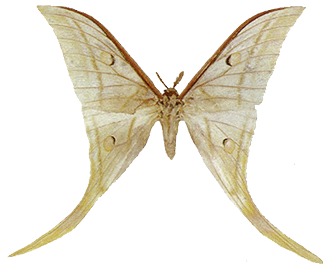|
Actias selene Hubner
Echidna selene Hubner, 1806, Samml. exot. Schmett. 113.
Actias selene seitzi Kalis, 1934, Ent. Rundschau, 51: 210.
Actias selene miae Toxopeus, 1944, Treubia (hors serie): 146.
Actias selene vandenberghi Roepke, 1956, Tijdschr. Ent. 99: 23.
Actias selene Hubner; Allen, 1981: 112; Lampe, 1985: 9.
|

Actias selene ♂
(.65
natural size)
|
Diagnosis.
Both sexes are a pale emerald green. The species is smaller than the next, with
shorter tails and faint yellow fasciae rather than brownish ones. The forewing
ocellus is dark brown in a crescent over the basal sector, rather than the
distal one (maenas).
Taxonomic notes. Only Sundanian nomenclature for selene is listed: vandenberghi
is applicable to Sumatran material and seitzi (= miae) to Javan material. Other
synonyms are listed by Arora & Gupta (1979).
Geographical range. Afghanistan through the Indian Subregion to China and Korea,
and south to Sundaland.
Habitat preference. The species is rare, only encountered in lowland forest,
though in Sumatra it may be montane (W.A. Nassig, pers. comm.).
Biology. The Indian larva is illustrated by Horsfield & Moore (1858-1859).
It is bright green with a narrow yellow stripe laterally. Above and below this
stripe there is a red spot or scolus on each segment. T2 and T3 each bear a pair
of conical processes dorsally; these have a red subapical band and bear numerous
setae; a similar process occurs centrally on A8 but intervening segments bear
setose red tubercles. The anal segment is posteriorly broadly black.
Host-plants recorded (Arora & Gupta, 1979; Sevastopulo, 1940; Bell, MS) are:
Lannea, Mangifera (Anacardiaceae); Terminalia (Combretaceae); Coriaria
(Coriariaceae);
Corylus (Corylaceae); Andromeda (Ericaceae); Quercus (Fagaceae);
Juglans (Juglandaceae);
Lawsonia (Lythraceae); Hibiscus (Malvaceae); Azadirachta, Cedrela
(Meliaceae);
Moringa (Moringaceae); Ligustrum (Oleaceae); Rhamnus (Rhamnaceae);
Malus, Prunus,
Pyrus (Rosaceae); Zanthoxylum (Rutaceae); Salix (Salicaceae).
<<Back
>>Forward <<Return
to Contents page
|

